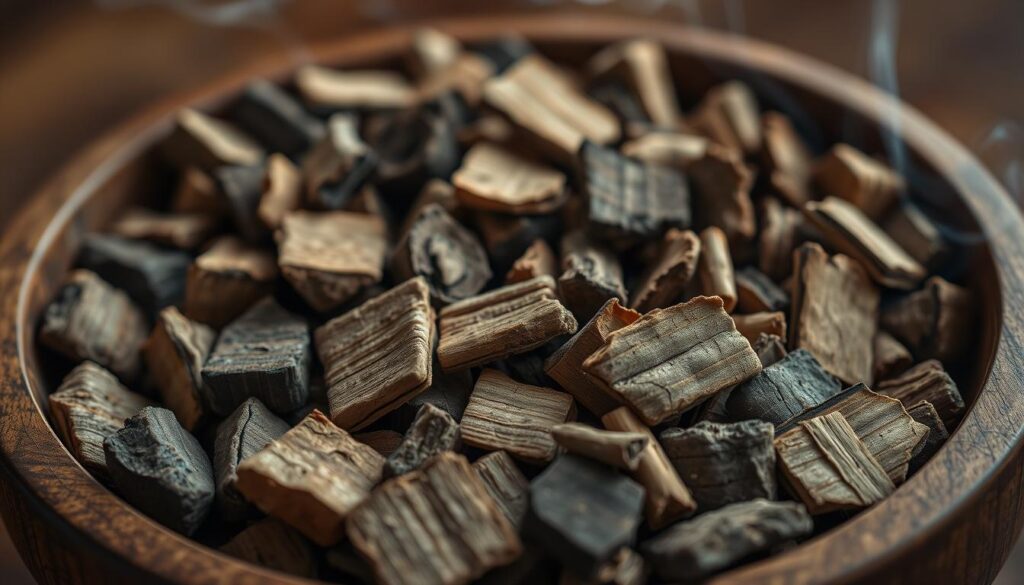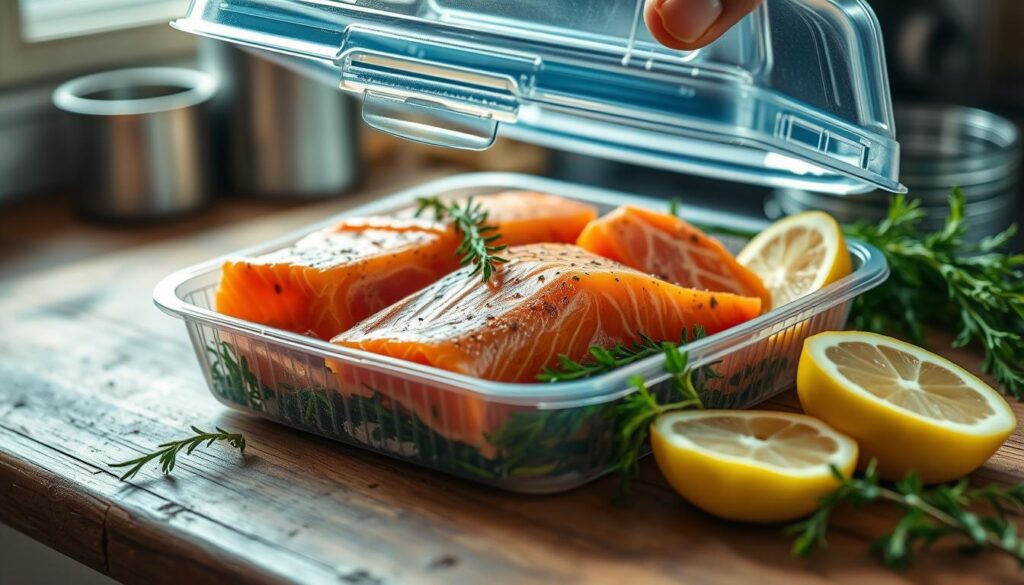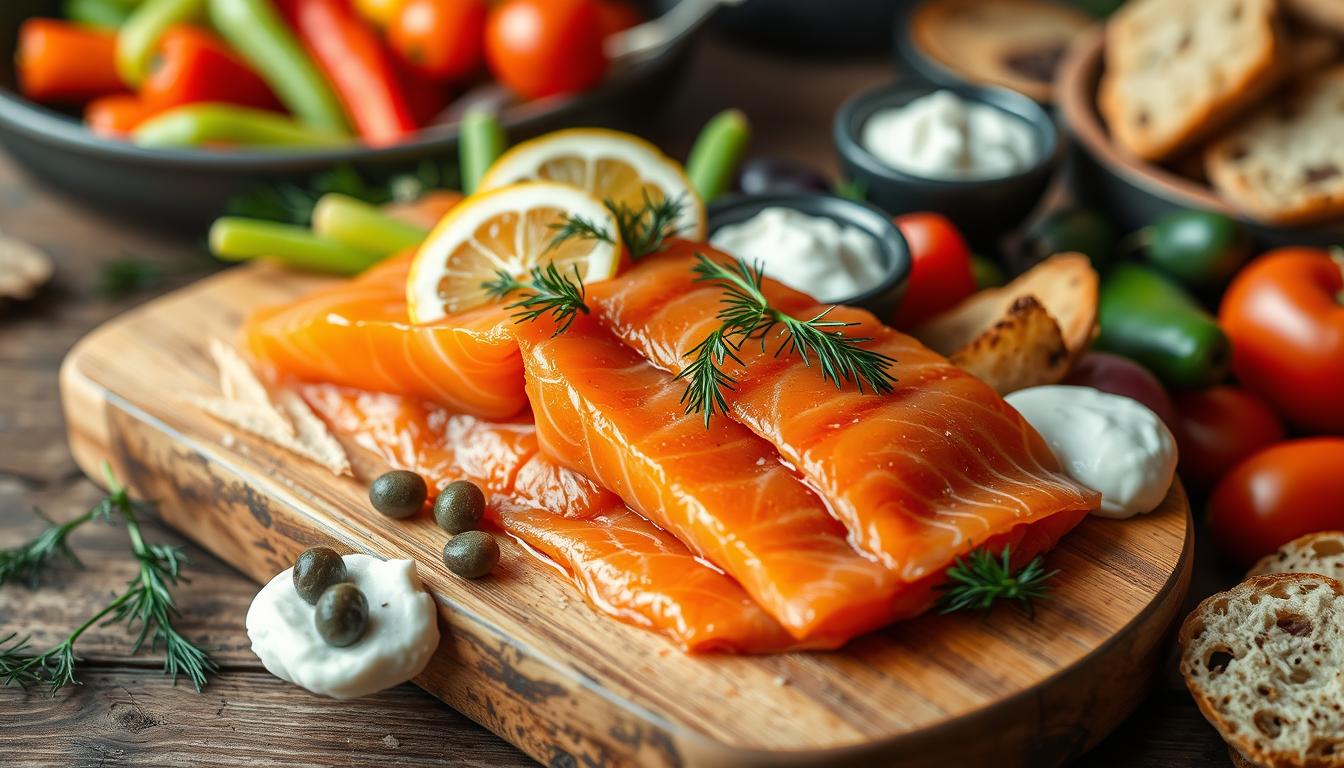Table of Contents
Smoked Salmon Recipe
I love seafood, and smoked salmon is my favorite. Its smooth texture and wood smoke flavor remind me of cozy kitchens and the sea. Today, I’m excited to share a simple recipe to bring these flavors to your home.
Smoked salmon can make any dish special. It’s perfect for gatherings or a quiet moment. This recipe will help you create a dish that will delight your taste buds.
Introduction to Smoked Salmon
Smoked salmon is a tasty treat loved by many. It’s made through hot or cold smoking, giving it special flavors and textures. Long ago, people smoked salmon to keep it fresh before refrigerators were invented.
What is Smoked Salmon?
Smoked salmon is made by curing and then smoking the fish slowly. Hot-smoked salmon is cooked at 225°F, making it firm and smoky. Cold-smoked salmon is cured longer and smoked at 70-85°F, making it silky and mild.
History of Smoked Salmon
Smoking salmon has been a tradition for indigenous peoples in North America and Canada. They used smoke from wood fires to keep salmon fresh for centuries. Over time, different tribes developed their own ways of making smoked salmon.
Health Benefits of Smoked Salmon
Smoked salmon is not just tasty but also very healthy. It’s full of omega-3 fatty acids, which are good for your heart, reduce inflammation, and help your brain. It’s also packed with protein, vitamins, and minerals, making it great for your diet.
Choosing the Right Salmon
When picking the perfect salmon for smoking, quality and source matter a lot. Both wild-caught and farmed salmon are great, depending on what you like and can afford.
Wild-Caught vs. Farmed Salmon
Wild-caught salmon, like King (Chinook), are famous for their deep red color and rich taste. They have a firm, flaky texture. This makes them perfect for smoking because they keep moisture well.
Farmed Atlantic salmon has a milder taste and lighter color. But, it also has a lot of fat, making it great for smoking.
Freshness Indicators
- Choose salmon that looks bright and shiny, with firm flesh that bounces back.
- Stay away from fish with a bad smell or color changes.
- The eyes should be clear, not cloudy or sunk.
Sustainable Sourcing Options
If you care about the environment, look for sustainable salmon. Use tools like the Local Catch Seafood Finder to find good suppliers. They focus on fishing and farming the right way.
“Choosing the right salmon is crucial for achieving the perfect smoked flavor and texture. Wild-caught King salmon and farmed Atlantic salmon are both excellent options, as long as they are fresh and sourced from sustainable suppliers.”
Essential Ingredients for Smoked Salmon
Making perfect smoked salmon starts with the right ingredients. Each part, from the brine to the smoking wood, is key. They work together to give the salmon its flavor and texture. Let’s explore the must-haves for a delicious smoked salmon.
Types of Brines
You can choose between dry brine and wet brine. A dry brine uses kosher salt and brown sugar. It keeps the salmon moist and brings out its natural taste. A wet brine, with water, salt, and sugar, adds more saltiness and a firmer texture.
Flavor Enhancers
Add flavor to your smoked salmon with ingredients like lemon pepper seasoning. It gives a zesty, slightly spicy taste. Try other herbs and spices, like dill, garlic, or maple syrup, to make your own special mix.
Wood Chips for Smoking
Alder wood is the top pick for smoking salmon. It adds a light, sweet smoky flavor. But, you can also try apple or cherry wood for a fruity twist. Avoid strong woods like mesquite or hickory, as they can overwhelm the salmon’s taste.
With the right brine, flavor enhancers, and smoking wood, you’re set to make amazing smoked salmon.
| Ingredient | Recommended Options |
|---|---|
| Brine | Dry Brine (Kosher Salt, Brown Sugar), Wet Brine (Water, Salt, Sugar) |
| Flavor Enhancers | Lemon Pepper Seasoning, Dill, Garlic, Maple Syrup |
| Smoking Wood | Alder, Apple, Cherry |

“The key to great smoked salmon is finding the perfect balance between the natural salmon flavor and the delicate smokiness from the wood.”
The Smoking Process Explained
Smoking salmon is a traditional method that adds a unique flavor and texture. It’s important to know the difference between cold and hot smoking to get the best results. We’ll look at both methods and give you a step-by-step guide to help you smoke salmon perfectly.
Cold Smoking vs. Hot Smoking
Cold smoking happens at temperatures below 90°F (32°C). It takes longer, from six to 24 hours, and gives a soft texture and mild smoky taste. On the other hand, hot smoking uses higher temperatures, between 120°F to 180°F (49°C to 82°C), for a shorter time. This method makes the salmon firmer and more smoky.
Step-by-Step Smoking Instructions
- First, heat your smoker to the right temperature. This depends on whether you’re cold smoking (90°F) or hot smoking (225°F).
- Then, put the brined and dried salmon on the smoker grates. Make sure they don’t touch each other.
- If you’re hot smoking, keep going until the salmon’s internal temperature hits 140°F.
- Keep an eye on the temperature. Use a dual-channel thermometer to keep it steady.
Tips for Temperature Control
- Use a water pan in the smoker to control the temperature and keep the fish moist.
- Adjust the vents or dampers to manage air flow and keep the temperature right.
- Be ready to add more wood chips or charcoal to keep the smoking going.
By understanding cold and hot smoking and following these steps, you’ll make delicious cold-smoked salmon or hot-smoked salmon. Your family and friends will love it.
Preparing Your Salmon
Creating the perfect smoked salmon begins with preparation. Start by cleaning and trimming your salmon well. Remove any pin bones and excess fat for even texture. This step is key for a smooth smoking process.
Brining Techniques
Brining adds flavor and keeps the salmon moist. You can use a dry or wet brine. For dry brine, rub salt and sugar on the salmon, cover, and refrigerate for 1-12 hours. For wet brine, dissolve salt, sugar, and spices in water, then soak the salmon for the same time.
Resting Period Before Smoking
Rinse the salmon and dry it well. Let it rest, uncovered, in the fridge for up to 24 hours. This time helps form a pellicle, which holds smoke and moisture.
By following these steps, your smoked salmon will turn out great. Clean trimming, flavorful brining, and pellicle formation are essential. They ensure a delicious final product with great taste and texture.
Smoking Equipment Needed
To make perfect smoked salmon at home, you need the right tools. The smoker you pick – like an electric smoker or charcoal smoker – affects the taste and texture of your salmon.
Smoker Types
There are many smokers to choose from:
- Electric Smokers – They control temperature well and are easy to use, perfect for beginners or those with little space.
- Charcoal Smokers – They give a real wood-fired taste and let you control the smoking process closely.
- Gas Smokers – They mix the ease of electric with the taste of charcoal but need more watching during use.
- Pellet Grills – These can grill and smoke, using wood pellets for a smoky flavor.
Necessary Tools and Accessories
Along with your smoker, you’ll need some key tools and accessories:
- A good probe thermometer to check the salmon’s internal temperature
- Fish tweezers or needle-nose pliers for handling the salmon fillets
- Aluminum foil or parchment paper for a drip tray to avoid mess
- Wood chips or chunks in your favorite flavor, like alder or maple
Safety Precautions
Smoking salmon at home needs careful safety steps. Always follow your smoker’s instructions, keep good air flow, and wear heat-resistant gloves. With the right gear and safety steps, you’ll make tasty smoked salmon in your backyard.

Flavor Variations for Smoked Salmon
Explore a world of flavors to elevate your smoked salmon. Try fresh herbs and spices for endless possibilities. Move past lemon-dill and get creative in the kitchen.
Adding Herbs and Spices
Add herbs like dill, thyme, or rosemary for a fragrant touch. Mix paprika, garlic powder, and black pepper for a smoky flavor. Try citrus zest or ground fennel seeds for something new. The choices are endless to spice up your salmon seasoning.
Unique Marinades to Try
- Maple-glazed salmon: Mix maple syrup, soy sauce, and Dijon mustard for a sweet glaze.
- Herb-crusted salmon: Use breadcrumbs, parsley, and lemon zest for a crunchy crust.
- Citrus-infused salmon: Marinate in orange, lime juice, and honey for a tangy taste.
Experimenting with Different Woods
Smoking with different woods changes your smoked salmon‘s flavor. Try apple, cherry, or oak woods. Cherry and maple woods mix for a sweet taste.
| Wood Type | Flavor Profile |
|---|---|
| Applewood | Mild, sweet, with fruity notes |
| Cherrywood | Delicate, sweet, with fruitiness |
| Oakwood | Bold, earthy, nutty |
| Mesquite | Intense, smoky, spicy |
“The combinations are endless when it comes to flavoring smoked salmon. I love experimenting with different herb and spice blends to create unique and delicious results.”
Serving Suggestions for Smoked Salmon
Smoked salmon is great for many dishes, from breakfast to appetizers. It’s perfect for any event or a tasty meal at home. There are many ways to use this delicious seafood in your cooking.
Classic Pairings
One favorite way to enjoy smoked salmon is on a bagel with cream cheese. The cheese’s creamy texture goes well with the smoky salmon. Add capers, red onion, and lemon for a classic brunch dish.
Creative Salad Ideas
- Mix smoked salmon with greens, avocado, and lemon vinaigrette for a refreshing salad.
- Try smoked salmon, roasted beets, arugula, and honey mustard dressing for a colorful salad.
- For something more filling, combine smoked salmon with quinoa, cucumber, tomatoes, and feta cheese.
Using in Sushi and Rolls
Smoked salmon is great in sushi and rolls. It adds a rich flavor and a nice pink color. Use it in California rolls, salmon avocado rolls, or in a smoked salmon sushi bowl with rice, avocado, and soy sauce.
| Serving Suggestion | Amount of Smoked Salmon Needed |
|---|---|
| Smoked Salmon Party Platter (4-6 people) | 12 ounces to 1 pound |
| Smoked Salmon Breakfast Tart (1 tart) | 1 sheet of premade puff pastry |
| Smoked Salmon Hollandaise Sauce (4 servings) | 10 minutes of roasted asparagus |
| Smoked Salmon Risotto (4 servings) | 3 tablespoons of melted butter |
| Smoked Salmon Mashed Potato (1 serving) | 5 minutes of microwaved potato |
Smoked salmon is very versatile. You can try many different ways to serve it, from classic dishes to creative salads and sushi. Experiment with flavors and styles to find your favorites.
Storing Smoked Salmon
Storing your homemade smoked salmon right is key to keeping its taste and texture great. Whether you’re eating it now or saving it for later, knowing how to store it is important.
Refrigeration Tips
For short-term storage, keep smoked salmon in the fridge for 2-3 weeks. Or up to 1 week after opening. Wrap it tightly in plastic wrap or use an airtight container to keep it moist and fresh.
Freezing Smoked Salmon
To enjoy smoked salmon longer, freeze it for up to 3 months. Vacuum-seal it or use freezer-safe bags, removing air to avoid freezer burn. Thaw it in the fridge overnight before eating.
How to Identify Spoiled Salmon
To check if smoked salmon is still good, look for signs of spoilage. Bad color, slimy feel, or a strong bad smell mean it’s gone bad. If it doesn’t look, smell, or feel right, it’s best to throw it away.
| Storage Method | Shelf Life |
|---|---|
| Refrigerated (unopened) | 2-3 weeks |
| Refrigerated (opened) | Up to 1 week |
| Frozen | Up to 3 months |
Remember, proper storage and handling of smoked salmon is key for food safety and quality. By following these tips, you can enjoy your homemade smoked salmon at its best, now or later.

Common Mistakes to Avoid
Making perfect smoked salmon needs skill and focus. The process might seem simple, but there are common mistakes. Knowing these can help you make great smoked salmon every time.
Over-Brining Your Salmon
Brining the salmon is a key step. But, it’s easy to add too much salt. Stick to the right brine-to-fish ratio and watch the salmon while it brines. Too long in the brine can make it too salty.
Inconsistent Temperature Maintenance
Keeping the temperature steady is crucial. If the temperature changes, the salmon might dry out or cook unevenly. Keep an eye on the temperature and adjust as needed. Using a reliable smoker with precise controls helps a lot.
Skipping Quality Checkpoints
There are important steps to check during smoking. Missing these can lead to poor salmon. Make sure the salmon gets a good pellicle, check its internal temperature, and look for doneness. These steps are key to perfect smoked salmon.
“Paying close attention to the details is the key to mastering the art of smoked salmon. Avoid these common mistakes, and you’ll be well on your way to creating a delicious, restaurant-quality dish at home.”
| Mistake | Consequence | Solution |
|---|---|---|
| Over-Brining | Overly salty salmon | Follow recommended brine-to-fish ratio, monitor brining time |
| Inconsistent Temperature | Dried out or undercooked salmon | Carefully maintain optimal smoking temperature |
| Skipping Quality Checks | Subpar final product | Regularly monitor for proper pellicle, doneness, and internal temperature |
Pairing Drinks with Smoked Salmon
Enjoying smoked salmon is even better with the right drink. White wines and craft beers can make the taste experience richer. They complement the smoky flavor of the salmon perfectly.
Best Wines to Compliment Smoked Salmon
White wine fans might like a chilled Sauvignon Blanc or Chablis. These wines have bright acidity and citrus flavors that balance the salmon’s oiliness. A light-bodied Pinot Noir is also great, with its fruity flavors and smooth tannins.
Craft Beer Options
Beer lovers should try a wheat beer or light lager with smoked salmon. These beers are sweet and crisp, contrasting the salmon’s bold taste. Wheat beers, with their citrus and spice, enhance the salmon’s flavor.
Non-Alcoholic Pairing Ideas
Non-alcoholic fans have great options too. Sparkling water with lemon is refreshing and cleanses the palate. Iced green tea is earthy and sweet, making a nice match. A cucumber-mint mocktail adds a vibrant contrast to the salmon.
Choosing the right drink is all about flavor balance. Try different drinks to find your favorite way to enjoy smoked salmon.
Conclusion and Final Thoughts
Creating the perfect smoked salmon is all about quality, brining, and temperature control. By following these steps, you’ll make delicious, moist, and tender salmon. It will wow your friends and family.
Recap of Key Points
Choose high-quality, sustainable salmon for the best taste and texture. Watch the brining and smoking closely to get it just right. Try different herbs, spices, and wood chips to make your own unique recipe.
Encouragement to Experiment and Enjoy
Don’t be shy to try new things with smoked salmon. It’s great in bagels, salads, and sushi. Cooking is all about exploring, so enjoy making your smoked salmon creations.
Invitation to Share Your Own Recipes
We want you to join our smoked salmon community and share your recipes. If you’ve found a new brining method or secret ingredient, we’re all ears. Sharing helps us all get better at making amazing smoked salmon.
FAQ
What is the difference between hot-smoked and cold-smoked salmon?
Hot-smoked salmon is brined briefly and cooked at around 225°F. Cold-smoked salmon is cured longer and smoked at a lower temperature of around 90°F. Hot-smoked salmon is fully cooked and flaky. Cold-smoked salmon is silkier and cured.
What type of salmon is best for smoking?
Wild-caught King (Chinook) salmon and farmed Atlantic salmon are great for smoking. They have high fat content. Choose fresh salmon with firm flesh and no strong odors.
What ingredients are needed for a basic smoked salmon brine?
A simple dry brine of kosher salt and brown sugar works well. Lemon pepper seasoning is a popular choice. Alder wood is the top choice for smoking, offering a delicate, slightly sweet flavor.
How long should the salmon be brined and rested before smoking?
Brine the salmon for 1-12 hours or wet brine. Rinse and let it rest uncovered in the fridge for up to 24 hours. This helps the smoke adhere and locks in moisture.
What type of smoker is best for making smoked salmon?
You can use electric, gas, charcoal, or pellet grills. You’ll need a probe thermometer, fish tweezers, and aluminum foil. Make sure to follow the manufacturer’s instructions for your smoker.
How long does smoked salmon last, and how should it be stored?
Store smoked salmon in the fridge for 3-5 days, wrapped tightly. For longer storage, freeze for up to 6 months in vacuum-sealed bags. Check for discoloration, sliminess, or a strong odor to avoid spoilage.
What are some common mistakes to avoid when making smoked salmon?
Avoid over-brining to prevent too much salt. Keep the smoker temperature consistent to avoid drying out or undercooking. Always check for proper pellicle formation, internal temperature, and doneness.
Source Links
- How to Smoke Salmon – https://www.theslowroasteditalian.com/how-to-smoke-salmon/
- Smoked Salmon in the Oven – https://www.tasteofhome.com/recipes/easy-smoked-salmon/?srsltid=AfmBOoq_Is97dH_oGuxmgLxmDhk6t7tAaRT0PfcTLRJqlyAZwbs3ft0h
- The Yummiest Smoked Salmon Recipe – https://happyhomealaska.com/the-yummiest-smoked-salmon-recipe/
- Easy Homemade Smoked Salmon – https://www.osharak.com/easy-homemade-smoked-salmon/
- Acme’s Top 40 Smoked Salmon Recipes – Acme Smoked Fish – https://acmesmokedfish.com/blogs/news/acme-s-top-40-smoked-salmon-recipes
- 30 of Our Favorite Smoked Salmon Recipes – https://www.foodandwine.com/smoked-salmon-recipes-8683241
- How to Smoke Salmon at Home – https://www.seriouseats.com/how-to-smoke-salmon-recipe-8621746
- How to Smoke Salmon – https://iowagirleats.com/how-to-smoke-salmon/
- Smoked Salmon in the Oven – https://www.tasteofhome.com/recipes/easy-smoked-salmon/?srsltid=AfmBOooTXO5_04BshAduoSQfwL3to_H36FqegQqTQGZqTSsCCxa7_Z9p
- Smoked Salmon – https://www.wellplated.com/smoked-salmon/
- Teriyaki Smoked Salmon – https://www.smokedmeatsunday.com/smokedsalmonrecipe/
- How is cold smoked salmon made? Trade secrets revealed… – https://smokin-brothers.com/blogs/blog/how-is-cold-smoked-salmon-made-trade-secrets-revealed?srsltid=AfmBOor9Iz9uZXh7fy_60bVt1xCm0rlPs5nb2bOw8CsEs-uY3mq-dWe1
- How to Smoke Fish – https://wildgameandfish.com/how-to-smoke-fish/
- CIA Technique of the Quarter: The Smoking Process – https://www.ciachef.edu/wp-content/uploads/2024/07/the-smoking-process.pdf
- Smoked Salmon in the Oven – https://www.tasteofhome.com/recipes/easy-smoked-salmon/?srsltid=AfmBOoo9J_TAPWQD0F6St6O6bWM4iUARn12HVIwUsITDpIdzMRcArtZO
- How To Make Perfect Smoked Salmon With Your Offset Smoker – Drizzle Me Skinny! – https://drizzlemeskinny.com/how-to-make-perfect-smoked-salmon-with-your-offset-smoker/
- Incredible Healthy Smoked Salmon – https://mondayismeatloaf.com/incredible-healthy-smoked-salmon/
- Simple Smoked Salmon – https://saltpepperskillet.com/smoked-salmon/
- How to Smoke Salmon – Acme Smoked Fish – https://acmesmokedfish.com/blogs/news/how-to-make-smoked-salmon
- Delicious Smoked Salmon Dishes to Try at Home – https://www.meatrecipes.net/smoked-salmon-dishes/
- Hot Smoked Salmon – https://overthefirecooking.com/hot-smoked-salmon/
- How to Serve Smoked Salmon: 24 Ideas From Apps to Entrees – https://www.wikihow.com/Serve-Smoked-Salmon
- 13 Smoked Salmon Recipes That Take You From Breakfast to Dinner – https://www.marthastewart.com/smoked-salmon-recipes-8665265
- 17 Smoked Salmon Recipes That Are Packed With Flavor – https://www.realsimple.com/smoked-salmon-recipes-8387772
- How to Store, Serve and Eat Smoked Salmon – https://www.gourmetfoodstore.com/storingserving-smoked-salmon-15156
- How to Safely Store Your Smoked Fish – Acme Smoked Fish – https://acmesmokedfish.com/blogs/news/how-to-safely-store-your-smoked-fish
- Avoid Making These 14 Mistakes When Cooking Salmon – Chowhound – https://www.chowhound.com/1567684/avoid-mistakes-cooking-salmon/
- Mastering the Perfect Blini with Smoked Salmon: Your Step-By-Step Guide – https://www.souschef.co.uk/blogs/the-bureau-of-taste/mastering-the-perfect-blini-with-smoked-salmon-a-beginners-guide?srsltid=AfmBOoovKx7hwq1PzU6qofS7bqik1_pultD-ieb-trLQfr48-0iCF4_h
- Traeger Smoked Salmon With Garlic Dijon Herb Butter – https://www.fattybuttsbbq.com/recipes/traeger-smoked-salmon-with-garlic-dijon-herb-butter
- Cocktail & Canapé Pairings for Entertaining – https://abcfws.com/cocktails-and-canape-pairings?srsltid=AfmBOoqyk474IToCpGH_HAvE20dvmEaloi3FRa1YtfhTreTFuL0C7frK
- The Essential Guide to Wine Pairing with Salmon – https://www.tasteofhome.com/article/wine-pairing-with-salmon/?srsltid=AfmBOorXnQOzxmamtilxyxckWb-sChAxJsTreItqGWBLKqbc8PXbRQ12
- Irresistible Smoked Salmon And Cream Cheese Wraps (Taste the Goodness) – https://tealnotes.com/smoked-salmon-and-cream-cheese-wraps/
- delicious Smoked Salmon Dishes: Easy Recipes to Try – https://www.meatrecipes.net/delicious-smoked-salmon-dishes/
- Crispy Skin Salmon with Lemon Butter Sauce Recipe – Frozen Fish Direct – https://frozenfish.direct/recipe/crispy-skin-salmon-with-lemon-butter-sauce-recipe/

